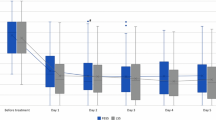Abstract
Purpose
We conducted a randomized, double-blinded study to test our hypothesis that caudal blockade as preemptive analgesia for low back surgery might accelerate time to walking exercise following surgery and reduce postoperative analgesics, thereby attaining faster recovery of cognitive function.
Methods
Our study included 51 elderly patients >70 years with American Society of Anesthesiologists (ASA) physical status 1–3, who underwent lumbosacral surgery under general anesthesia. After anesthetic induction and tracheal intubation, patients in the study group (group B) were injected with simple 0.5% bupivacaine [10 ml × height (m)] as a caudal block 15 min before surgical incision, whereas patients in the control group (group C) received normal saline. After surgery, patients had access to intravenous patient-administered analgesia (IV PCA), fentanyl, for postoperative pain relief. We assessed Mini-Mental State Examination (MMSE) scores before and after the surgery, values of visual analog scale (VAS) for postoperative analgesic status, fentanyl consumption during and for 3 days after surgery, and time to begin walking exercise after surgery.
Results
VAS value of group B patients was significantly lower than those in group C throughout the postoperative 48-h period (p < 0.005), and group B patients began walking exercise significantly earlier than those in group C [mean ± standard deviation (SD) 70.2 (14.3) in group C, and 61.9 (7.6) in group B; p = 0.0133]. Cognitive function level was higher in group B than in group C patients 24 h after operation.
Conclusions
Caudal blockade as preemptive analgesia shortened the time to start walking exercise after surgery and accelerated recovery of postoperative cognitive function.




Similar content being viewed by others
References
Fong HK, Sands LP, Leung JM. The role of postoperative analgesia in delirium and cognitive decline in elderly patients: a systematic review. Anesth Analg. 2006;102:1255–66.
Duggleby W, Lander J. Cognitive status and postoperative pain: older adults. J Pain Symptom Manage. 1944;9:19–27.
Kundra P, Gurnani A, Bhattacharya A. Preemptive epidural morphine for postoperative pain relief after lumbar laminectomy. Anesth Analg. 1997;85(1):135–8.
Sekar C, Rajasekaran S, Kannan R, Reddy S, Shetty TAP, Pithwa YK. Preemptive analgesia for postoperative pain relief in lumbosacral spine surgeries: a randomized controlled trial. Spine J. 2004;4:261–4.
Kakiuchi M, Abe K. Pre-incisional caudal epidural blockade and the relief of pain after lumbar spine operations. Int orthop. 1997;21(1):62–6.
Folstein MF, Folstein SE, McHugh PR. “Mini-Mental State” a practical method for grading the cognitive state of patients for the clinician. J Psychiatr Res. 1975;12:189–98.
Fragen RJ, Dunn KL. The minimum alveolar concentration (MAC) of sevoflurane with and without nitrous oxide in elderly versus young adults. J Clin Anesth. 1996;8:352–6.
Woolf CJ, Chong MS. Preemptive analgesia-treating postoperative pain by preventing the establishment of central sensitization. Anesth Analg. 1993;77:362–79.
Beilin B, Bessler H, Mayburd E, Smirnov G, Denkel A, Yardeni I, et al. Effect of preemptive analgesia on pain and cytokine production in the postoperative period. Anesthesiology. 2003;98:151–5.
Hong JY, Lim KT. Effect of preemptive epidural analgesia on cytokine response and postoperative pain in laparoscopic radical hysterectomy for cervical cancer. Reg Anesth Pain Med. 2008;33(1):44–51.
Grass JA. Patient-controlled analgesia. Anesth Analg. 2005;101:S44–61.
Yokoyama M, Hanazaki M, Fujii H, Mizobuchi S, Nakatsuika H, Takahashi T, et al. Correlation between the distribution of contrast medium and the extent of blockade during epidural anesthesia. Anesthesiology. 2004;100:1504–10.
Burn JM, Guyer PB, Langdon L. The spread of solutions injected into the epidural space. A study using epidurograms in patients with the lumbosciatic syndrome. Brit J Anaesth. 1973;45:338–45.
Ishiyama T, Kashimoto S, Oguchi T, Yamaguchi T, Okuyama K, Kumazawa T. Epidural ropivacaine anesthesia decreases the Bispectral Index during the awake phase and sevoflurane general anesthesia. Anesth Analg. 2005;100:728–32.
Author information
Authors and Affiliations
Corresponding author
About this article
Cite this article
Kiribayashi, M., Inagaki, Y., Nishimura, Y. et al. Caudal blockade shortens the time to walking exercise in elderly patients following low back surgery. J Anesth 24, 192–196 (2010). https://doi.org/10.1007/s00540-009-0840-6
Received:
Accepted:
Published:
Issue Date:
DOI: https://doi.org/10.1007/s00540-009-0840-6




